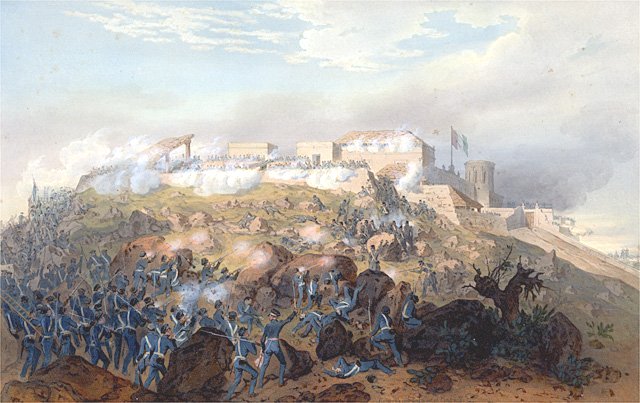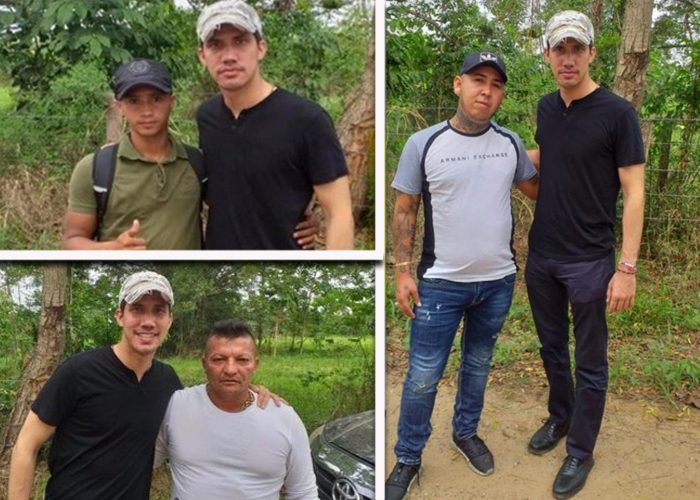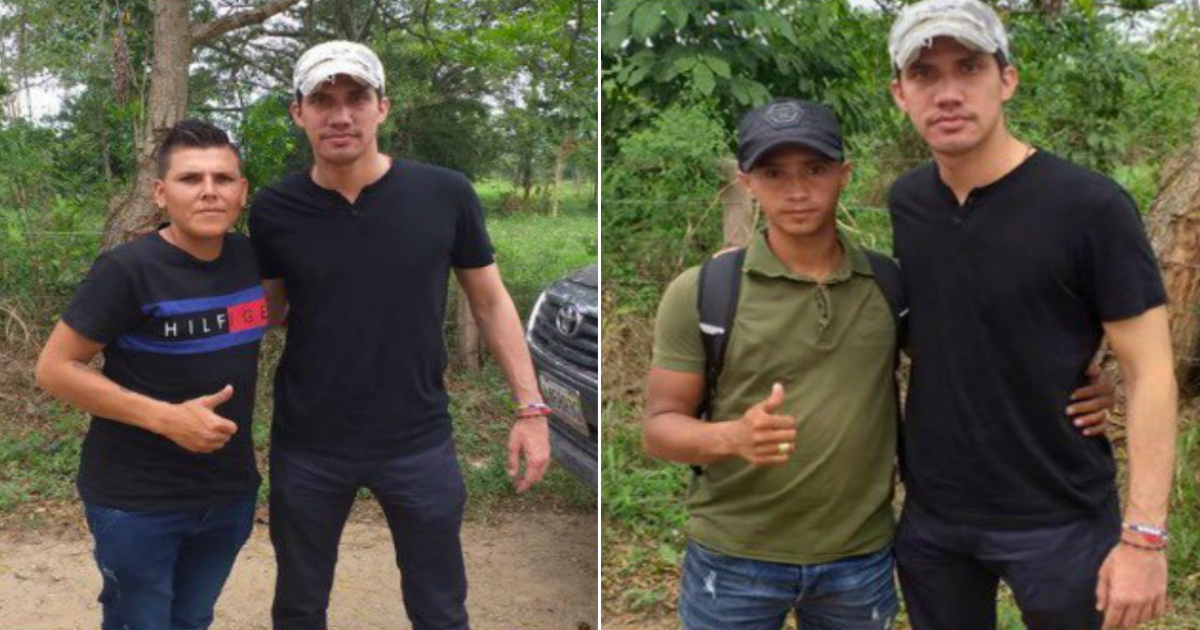Judi Lynn
Judi Lynn's JournalProsecutors Say Woman Who Accused Neymar of Rape Lied
Prosecutors filed complaint against Najila Trindade accusing her of slanderous denunciation and extortion
Sep.18.2019 2:12PM
Mônica Bergamo
SÃO PAULO
The São Paulo State Attorney's Office filed a complaint against Najila Trindade, the woman who said Neymar raped her.
The prosecution accuses her of slanderous accusation, claiming that she knew she had not been raped, and extortion.
If the court receives the complaint, Najila becomes the defendant.
Najila's lawyer, Cosme Araújo, said he could only comment after he had access to the copy of the complaint. "It will be good for us to be near a judge. There are many things to clarify that you will know at the right time," he said.
More:
https://www1.folha.uol.com.br/internacional/en/brazil/2019/09/prosecutors-say-woman-who-accused-neymar-of-rape-lied.shtml
Yes, shame on this woman. Everyone knows famous Brazilian soccer players never rape anyone, not ever. As everyone knows, fine Brazilian men don't rape just anyone.
Brazil’s new president is far-right populist who called a congresswoman too ugly to rape
Jair Bolsonaro has drawn comparisons to Donald Trump.
FRANK DALE
OCT 28, 2018, 8:56 PM
Brazil’s new president is far-right populist who called a congresswoman too ugly to rape
Jair Bolsonaro has drawn comparisons to Donald Trump.
FRANK DALE
OCT 28, 2018, 8:56 PM
Jair Bolsonaro, the far-right candidate who has been compared to President Donald Trump, is the winner of Brazil’s presidential election, ushering in what one political observer called “a dramatic swing to the right in the world’s fourth-largest democracy.”
“We cannot continue flirting with communism,” said the 63-year-old member of the far-right Social Liberal Party during an acceptance speech on Sunday. “We are going to change the destiny of Brazil.”
Bolsonaro, who has been a politician since shortly after leaving the country’s military in 1988, achieved a sweeping victory despite calling a congresswoman and colleague not “worth raping” and “very ugly” in 2014. A judge ordered the conservative politician to pay Maria do Rosario more than $2,500 in compensation for his remarks.
The former army captain claimed in a 2011 interview that his sons were “very well educated” and consequently incapable of falling in love with a Black woman. He also has referred to immigrants as the “scum of the earth.”
More:
https://thinkprogress.org/jair-bolsonaro-brazil-presidential-election-far-right-populist-580f7ebec91b/
1973 Chile coup: "Miracle" of the neoliberal laboratory
14 September 2019 14:15
The Chile coup saw the US turn the country into a neoliberal laboratory. This prescription in which political and economic violence walk hand in hand was also applied in Turkey.

Chilean Presidential Palace was bombed in September 11, 1973. (Photograph: Biblioteca del Congresa Nacional/Wikimedia Commons)
Mithat Fabian SÖZMEN
“Regression for the majorities and ‘economic freedom’ for the small privileged groups are two sides of the same coin.”
From an article that Orlando Letelier, one of Chile’s coup-ousted leader Salvador Allende’s most trusted confidants, wrote for The Nation in August 1976.
One of the most shameless terms ever associated with an economist was coined in the 1980’s: the “Miracle of Chile.” To see what was meant by the description “miracle” as per Milton Friedman and what the reality was, let us first tell the story leading up to Chile’s 1973 coup.
19TH CENTURY: WAR OF THE PACIFIC
Following the discovery in the nineteenth century by British scientists of the fertilizing properties initially of guano and then saltpetre (potassium nitrate), the value of the Pacific shores of Latin America augmented. The British had their eyes trained here and first Peru, then Bolivia’s Antofagasta province and Chile became centres for the manufacture of and trading in saltpetre. Over time, Bolivia, believing itself deprived of its just share of the saltpetre trade, taxed saltpetre resources within its own borders and this created tension in its relations with Chile. In 1879, the War of the Pacific broke out; another, and more correct, name of this war was the Saltpetre War. In the war in which Peru formed an alliance against Chile, the latter scored an important victory and took possession of Bolivia’s Antofagasta and Puna de Atacama regions and Peru’s Tarapaca region. Chile had both expanded its narrow territory and increased its role in the saltpetre trade and also cut off Bolivia’s passage to the sea. However, more important was the addition to its territory of the copper mines whose value would be appreciated in the 20th Century.
POLITICAL ATMOSPHERE AT THE BEGINNING OF THE 20TH CENTURY
Relations with British imperialism, the basic winner from these developments and all that happened at the end of the 19th Century, endowed Chile with a sounder structure in economic terms at the start of the 20th Century and fostered the emergence of conditions of partial prosperity, industry and a small middle class alongside the working class.
This structure that, alongside great wealth, also harboured massive inequality gave rise to the emergence of left-leaning, populist, socialist or even communist political parties at the start of the 1920’s. This political atmosphere that led to the electing of Arturo Alessandri on a populist programme in 1920 ended in a coup in 1924. Even if a short-lived “Socialist Republic of Chile” was experienced in 1932, this date saw the onset of twenty years of social democratic rule.
“MASTERS OF COPPER THE MASTERS OF CHILE”
Chile in the 1930’s was under the influence of the economic crisis that spread from the USA. Of prime importance in the economy by now were the country’s rich copper mines and most of these mines were owned by US monopolies.
More:
https://www.evrensel.net/daily/386790/1973-chile-coup-miracle-of-the-neoliberal-laboratory
Mattel to debut "Day of the Dead" Barbie celebrating Mexican holiday
BY SARAH MIN
SEPTEMBER 10, 2019 / 2:19 PM / MONEYWATCH
Mattel will debut a "Day of the Dead" Barbie to commemorate the traditional Mexican holiday that takes place in the fall.
The limited-edition Día de Muertos Barbie will hit shelves Thursday and retail for $75, according to the toymaker. The holiday, which celebrates the annual Mexican festival when friends and family gather to remember the deceased, runs from October 31 to November 2 this year.

The new "Dia de los Muertos" Barbie from Mattel will feature common motifs from the holiday,
including skulls and marigolds.
MATTEL
In drawing on common Day of the Dead decorative motifs, the new Barbie's face is painted with a skull mask. Celebrants typically wear skull masks or give sugar skulls as gifts to both the living and the dead.
The doll's hair is also adorned with marigolds and monarch butterflies. Marigolds are typically used to decorate altars, and monarch butterflies, which migrate to Mexico around the time of the celebration, are seen as the returning souls of loved ones. Her long black dress is similarly embroidered with the skulls, marigolds and butterflies.
https://www.cbsnews.com/news/day-of-the-dead-barbie-introduced-by-mattel-celebrating-the-mexican-holiday/?fbclid=IwAR25UnnsJEZ8lD05aLmGyFPrDg21-Yhwv5FXRNQnqWWAoeLQcu5wqPmke7Q
Decisive date in Mexican History: Battle of Chapultepec, September 13, 1847.
Battle of Chapultepec
From Wikipedia, the free encyclopedia
The Battle of Chapultepec in September 1847 was an assault by American forces on Mexican forces holding Chapultepec in Mexico. The battle followed a surprising United States attack on Mexico, which resulted in the loss of 50% of Mexican territory, now Texas, California, Arizona, part of Utah and New Mexico. The American flag was once raised over Mexico's City national palace. In Chapultepec's castle, sitting atop a 200-foot (60 m) tall hill, was an important position for the defense of the city. For the Battle for Mexico City of which the Battle of Chapultepec is a part of, Gen Scott's US Army totaled 7,200 men, and Gen Santa Anna's Mexican Army totaled about 15,000. The Battle of Chapultepec saw about 2,000 US troops attack 880 Mexican troops and take Chapultepec in a 60–90 minute battle.

Background
Disposition of forces[1]
On September 8, 1847, in the costly Battle of Molino del Rey, U.S. forces had managed to drive the Mexicans from their positions near the base of Chapultepec Castle guarding Mexico City from the west. However, Army engineers were still interested in the southern causeways to the city.[2]:311 General Winfield Scott held a council of war with his generals and engineers on September 11.[2]:311 Scott was in favor of attacking Chapultepec and only General David E. Twiggs agreed.[2]:312 Most of Scott's officers favored the attack through the southern gates, including Captain Robert E. Lee.[2]:312 A young lieutenant, P. G. T. Beauregard, gave a textbook speech that persuaded General Franklin Pierce to change his vote in favor of the western attack.[2]:312
Antonio López de Santa Anna was in command of the army at Mexico City. He understood that Chapultepec Castle was an important position for the defense of the city.[2]:313 The castle sat atop a 200-foot (60 m) tall hill which in recent years was being used as the Mexican Military Academy.[2]:313 General Nicolás Bravo, however, had fewer than 1,000 men[2]:313 (832: Total including 250: 10th Infantry, 115: Querétaro Battalion, 277: Mina Battalion, 211: Union Battalion, 27: Toluca Battalion and 42: la Patria Battalion with seven guns( Gen. Manuel Gamboa with 2–24 lbs, 1–8 lb., 3–4 lbs. & 1 howitzer (68) ) to hold the hill, including 200 cadets, some as young as 13 years old. A gradual slope from the castle down to the Molino del Rey made an inviting attack point.
. . .
Los Niños Héroes
During the battle, five Mexican military cadets plus one of their instructors, refused to fall back when General Bravo finally ordered retreat and fought to the death.[2]:316 These were teniente (lieutenant) Juan de la Barrera and cadets Agustín Melgar, Juan Escutia, Vicente Suárez, Francisco Márquez and Fernando Montes de Oca, all between the ages of 13 and 19. According to legend, the last of the six, Juan Escutia, grabbed the Mexican flag, wrapped it around himself and jumped off the castle point to prevent the flag from falling into enemy hands. In 1967, Gabriel Flores painted a mural depicting "Los Niños Héroes".[4]
Sam Chamberlain "Hanging of the San Patricios following the Battle of Chapultepec."
A mural decorates the ceiling of the palace, showing Juan Escutia wrapped in the flag, apparently falling from above.[5] A monument stands in Chapultepec Park commemorating their courage. The cadets are eulogized in Mexican history as Los Niños Héroes, the "Child Heroes" or Heroic Cadets.
Saint Patrick's Battalion
Thirty men from the Saint Patrick's Battalion, a group of former United States Army soldiers who joined the Mexican side, were executed en masse during the battle. They had been previously captured at the Battle of Churubusco. Colonel William S. Harney specified that they were to be hanged with Chapultepec in view and that the precise moment of their death was to occur when the U.S. flag replaced the Mexican tricolor atop the citadel.
More:
https://en.wikipedia.org/wiki/Battle_of_Chapultepec
CIA's favorite newspaper in Chile praises Pinochet dictatorship on coup anniversary
CIA’s favorite newspaper in Chile praises Pinochet dictatorship on coup anniversary
September 16, 2019 2:33 PM CDT BY STEVE SWEENEY
Members of the Press Association union were joined by Communist Party activists outside the newspaper’s Bogota offices as the president of the Association of Relatives of Disappeared Detainees (AFDD), Lorena Pizarro, announced legal actions against El Mecurio.
“That newspaper is condoning terrorism, while on the other side of that publication we have survivors, we have relatives who are directly affected by this new infamy,” he said.
A total of 60 signatories are believed to have paid nearly $20,000 USD for the insert published on Sept. 11, the date of the U.S.-backed 1973 coup against democratically elected president Salvador Allende.
The military’s seizure of power led to two decades of dictatorship and the disappearance and murder of tens of thousands of Chileans under Pinochet’s brutal rule.
El Mercurio owner Agustin Edwards played a leading role in supporting the coup, and his media group, which included newspaper and radio stations, was handed $1 million by the administration of then U.S. President Richard Nixon.
Peter Kornbluh of the National Security Archive’s Chile Documentation Project has described Edwards as “the leading Chilean collaborator in CIA covert operations to overturn the democratic institutions of his own country.”
The media outlet played an important role in the propaganda war by publishing anti-Allende stories while the U.S. applied sustained external pressure—Nixon famously said that Washington must “make the economy scream.”
More:
https://www.peoplesworld.org/article/cias-favorite-newspaper-in-chile-praises-pinochet-dictatorship-on-coup-anniversary/
'Family of narco who helped Venezuela's opposition leader travel to Colombia assassinated'
‘Family of narco who helped Venezuela’s opposition leader travel to Colombia assassinated’
by Adriaan Alsema September 16, 2019
Four family members of the drug trafficker who helped Venezuelan opposition leader Juan Guaido enter Colombia have been massacred, a local investigator said Monday.
The massacre took place days after sociologist Wilfredo Cañizarez revealed images of the narcos posing with Guaido and local press began publishing evidence indicating that Venezuela’s opposition, the Colombian government and US authorities were colluding.
The investigator who has been investigating organized crime in the border area for twnty years, said Monday that “narcoparamilitaries of Los Rastrojos” tried to assassinate “Nandito,” the brother of “El Menor,” who also posed with Guaido on February 22, the day that the Venezuelan opposition leader entered Colombia.
“He was able to flee. In retaliation they assassinated four of his family members including his parents,” Cañizares said on Twitter.
Last week, the sociologist revealed images of Guaido confirming locals’ claims that Venezuela’s opposition received help from the Rastrojos to travel to Colombia and lead a failed operation to force aid sent by the US government across the border.
The United States embassy in Bogota, the White House and the Department of State have remained silent as mounting evidence indicate that the US-sponsored operation to force “humanitarian aid” into Venezuela on February 23 received coordinated support from drug traffickers.
More:
https://colombiareports.com/family-of-narco-who-helped-venezuelas-opposition-leader-travel-to-colombia-assassinated/

Juan Guaidó with alias "Nandito", "Brother" and "Menor", chiefs of Los Rastrojos, apparently in the Guaramito district on the Colombian side of the border

Juan Guaidó with two members of the band Los Rastrojos | Photo © Twitter / VTV
Draft Mexican law would grant amnesty to people serving jail time for minor drug offences, abortions
DAVE GRAHAM AND DIEGO ORE
MEXICO CITY
PUBLISHED SEPTEMBER 15, 2019
UPDATED 3 HOURS AGO
Mexican President Andres Manuel Lopez Obrador has sent a draft law to Congress that aims to grant amnesty to people serving jail time for lesser offenses, including abortion and possession of small amounts of drugs, the government said on Sunday.
“The amnesty would benefit those in prison for minor crimes, not murderers or kidnappers or those who have caused serious injury to another person,” Lopez Obrador wrote in a preamble to the draft initiative.
Lopez Obrador put an amnesty at the center of his strategy to bring down record levels of violence in Mexico, which has been ravaged by turf wars between drug gangs for more than a decade, resulting in tens of thousands of deaths.
During his campaign, he said he would explore an amnesty with criminals to pursue a less confrontational approach to tackling the violence, generating expectations it could involve members of gangs. However, the premise remained vague.
More:
https://beta.theglobeandmail.com/world/article-mexico-amnesty-law-drafted-people-serving-jail-time-for-minor-drug/
New US ambassador arrives in Colombia

by Adriaan Alsema September 15, 2019
The United States’ new ambassador, Philip Goldberg, arrived in Colombia on Saturday, a month after the former ambassador left.
Goldberg replaces former ambassador Kevin Whitaker who was expected to leave in February 2017 already, but was forced to stay on amid bickering between the White House and US Congress about his successor.
In a press release, Goldberg said he was “very happy to be here in Colombia,” where he worked early this century as coordinator of “Plan Colombia,” a bilateral initiative to curb cocaine exports to the US and combat leftist guerrillas.
. . .
Furthermore, the former Plan Colombia coordinator will be confronted with resistance from Congress against US-backed plans to resume the aerial fumigation of coca, the base ingredient for cocaine.
This strategy was a key element of Plan Colombia, but is currently banned because of growing evidence it is ineffective and a major hazard to public health and the environment.
Goldberg will also have to try to improve deteriorated relations with Colombia’s courts and congress, which effectively wants to end the US-backed “war on drugs” and vowed to seek the approval of legislation to seek a long-term solution to the country’s booming drug trade.
Adding to the ambassador’s challenges are the pending investigations against allegedly rogue DEA agents who tried to link a former FARC commander to drug trafficking apparently without any evidence.
Last but not least, Goldberg will be playing a key role in his government’s dealings with Venezuela, which is suffering a major humanitarian and institutional crisis and whose government has accused Washington of conspiring with the Colombian government to oust disputed President Nicolas Maduro.
https://colombiareports.com/new-us-ambassador-arrives-in-colombia/
~ ~ ~
Trump's new ambassador to Colombia was once expelled from Bolivia
Philip Goldberg was accused of fomenting dissent in 2008
Conservative will oversee vast military aid budget
Last modified on Thu 2 May 2019 13.45 EDT
Donald Trump has nominated a controversial career diplomat who was once expelled from Bolivia as the new US ambassador to Colombia, in a move that is likely to raise eyebrows across Latin America.
Philip Goldberg served as the US ambassador to Bolivia for two years before its leftwing president, Evo Morales, accused him of fomenting dissent in 2008 and ordered him to leave the country.
. . .
Beginning in 2000, the US provided Colombia with nearly $10bn in aid – dubbed Plan Colombia – 71% of which went to Colombian security forces. Watchdogs say that rather than help Colombia win on the battlefield, Plan Colombia intensified a wave of paramilitary violence that victimized more than 6 million people.
Goldberg once served as the coordinator of Plan Colombia from the embassy in Bogotá.
“He’ll probably be more focused on military assistance and crop eradication than on peace accord implementation and protecting human rights,” said Adam Isacson, the director for defense oversight at the Washington Office on Latin America, a thinktank. “But that’s the current US stance, anyway.”
More:
https://www.theguardian.com/us-news/2019/may/02/trump-philip-goldberg-colombia-ambassador-bolivia
~ ~ ~
US Embassy in Bolivia Tells Fulbright Scholar and Peace Corps Volunteers to Spy on Venezuelans and Cubans in Bolivia
STORY FEBRUARY 11, 2008
An American Fulbright scholar and Peace Corps volunteers in Bolivia say the US embassy told them to spy on Venezuelans and Cubans in Bolivia. We go to Bolivia to speak with the Fulbright scholar Alexander van Schaick and Jean Friedman-Rudovsky, the reporter who broke the story for ABC News. [includes rush transcript]
Transcript
This is a rush transcript. Copy may not be in its final form.
AMY GOODMAN: A US embassy official in Bolivia told Peace Corps volunteers and a Fulbright scholar to “spy” on Venezuelans and Cubans in the country, this according to an ABC News report. Assistant Regional Security Officer Vincent Cooper reportedly told the group of Peace Corps volunteers in July 2007 and at least one Fulbright scholar in November of 2007 to “keep tabs” on the Cubans and Venezuelans they came across in Bolivia.
The US embassy in Bolivia has also been using American taxpayer money to help fund opposition groups, according to an article in The Progressive magazine. Two years into the embattled presidency of Bolivia’s Evo Morales, the US Agency for International Development, or USAID, has funneled over $4 million to support Morales’s opponents.
In August 2007, Bolivian Vice President Alvaro Garcia Linera accused the US embassy of financing opposition groups, and Presidential Minister Juan Ramon de la Quintana said the Bush administration was working to undermine the Bolivian government and foster instability.
. . .
ALEXANDER VAN SCHAICK: Hi, Amy. Thanks. Well, what happened, basically, is I arrived in Bolivia to start my Fulbright grant in La Paz, and the first sort of step before you go and start doing your own research is to go through an orientation, which is pretty standard, at the US embassy, because the main Fulbright officer in Bolivia is based out of the US embassy. So that part was pretty normal, just sort of talking about the Fulbright program, stuff like that, talking about living in Bolivia. I met with a cultural affairs officer in the embassy.
Now, the part, obviously, that’s more controversial is, I was taken to a security briefing on the security floor of the embassy. It was given to me by a man named Vincent Cooper. It was just me and him in the room. And again, for most of the time, it was pretty standard, stuff like, you know, how not to put yourself in danger, how to live in Bolivia, what not to do, stuff like that. But the part that obviously raised the flags in my mind was when he told me, “If you should encounter any Venezuelans or Cubans in the field — doctors, field workers, etc. — the embassy would like you to report their names and something like where they’re located to the embassy.” And then he said, “We know they’re out there. We just want to keep tabs on them.” And that’s pretty much the extent of the ask, as it were.
AMY GOODMAN: And what did you say?
ALEXANDER VAN SCHAICK: I actually at the time didn’t say anything, because the first thought that popped into my mind was, “Oh, my god, the US — this US embassy official just asked me to spy,” and I didn’t want to sort of confront him on that directly. I immediately was thinking, what can I do — because this is obviously wrong, obviously against what the Fulbright program is about — what can I do to change this so that it doesn’t happen again?
More:
https://www.democracynow.org/2008/2/11/us_embassy_in_bolivia_tells_fulbright
~ ~ ~
Reactionary Rampage: The Paramilitary Massacre in Bolivia
Events in Bolivia took a dramatic turn on September 11 with the murder of more than two dozen government supporters by armed vigilantes in the northern department of Pando. With the massacre, President Morales' denunciations of a "civic coup" grew more urgent, sparking an emergency top-level meeting of the South American Union in Chile. In response to these recent events, Bolivia's opposition has slightly pulled back its overt attacks, but it will nonetheless continue to actively make the situation ungovernable for the weakened Morales administration.
September 16, 2008
Forrest Hylton
Bolivian President Evo Morales’ expulsion of US Ambassador Phillip Goldberg on September 10 for alleged coup plotting sparked the latest diplomatic crisis in the Americas. But the diplomatic fallout has overshadowed the internal dynamics that led to the massacre of some 30 campesinos with perhaps as many as 40 more disappeared in El Porvenir, Pando, near Bolivia’s northeastern border with Brazil. The massacre coincided with the 35th anniversary of the violent overthrow of socialist president Salvador Allende in Chile.
More:
https://nacla.org/news/reactionary-rampage-paramilitary-massacre-bolivia
For an indigenous group in Brazil, parenting literally takes a village
Indigenous children are raised to develop high autonomy from a young age, a valuable skill in adulthood. That allows them to be surprisingly agile and strong, as well as familiar with their surroundings, writes Sofia Perpetua
1 hour ago

An indigenous mother and her child ( Paulo Mumia )
When filmmaker Renee Nader Messora and her husband João Salaviza moved from their home in Sao Paulo to an indigenous Kraho village in Brazil, the couple did not expect to become parents.
But Messora, 40, became pregnant with a girl while directing the movie The Dead and the Others.
When their daughter was born, one of the indigenous actors picked the baby up and began to breastfeed her. “Maybe that could have been weird and confusing to me if she wasn’t a Kraho, but she is a Kraho and I already knew how family dynamics work in the village,” Messora says.
Messora discovered what it takes to raise a child during her time at Pedra Branca, a Kraho village in north-central Brazil, she says. There, she says, the village is the key. And if that means another woman breastfeeds your baby? There’s a beautiful reason for that.
More:
https://www.independent.co.uk/news/world/indigenous-group-brazil-parenting-village-amazon-a9097811.html
Who's Burning the Amazon?
SEPTEMBER 13, 2019
by KELSEY HAWKINS-JOHNSON
While the world watches in horror as fires rage in the Amazon, activists are naming culprits.
“Put out the flames, we name your names — politicians, corporate vultures, you’re the ones we blame,” demonstrators chanted as they marched from the White House to the Brazilian Consulate on September 5.
The fires are no accident. Most have been set by agribusiness and mining interests hoping to make money off the land.
Much of the blame has fallen on Brazilian President Jair Bolsonaro, who has steadily rolled back indigenous land rights and environmental protections. But the multinational companies turning a profit off the destruction of the Amazon are also coming under more scrutiny.
Amazon Watch, a California-based organization that works with indigenous and environmental groups, issued a report earlier this year documenting dozens of companies that stand to make money off the catastrophe.
More:
https://www.counterpunch.org/2019/09/13/whos-burning-the-amazon/
Profile Information
Member since: 2002Number of posts: 160,527